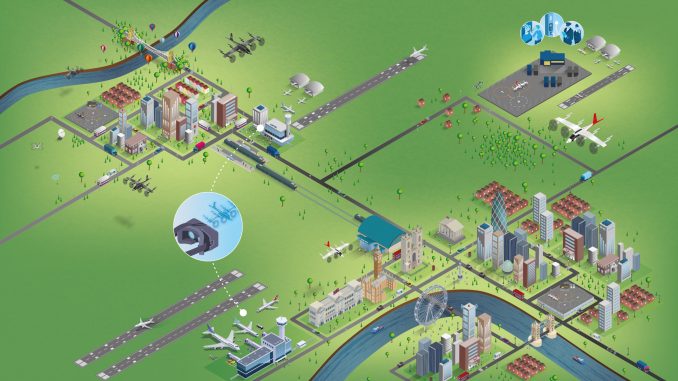
The Air Mobility Ecosystem Consortium continues to make strides in its mission to demonstrate the commercial and operational viability of Advanced Air Mobility (AAM) in the United Kingdom, says a consortium press release.
“As we move through 2024, the Consortium’s diverse group of aviation industry leaders is working collaboratively to bring the vision of electric vertical take-off and landing (eVTOL) aircraft operations closer to reality. The Consortium, backed by a UKP9.5 million grant from the UK Government’s Future Flight Challenge, brings together aviation specialists including Vertical Aerospace, AtkinsRéalis, Skyports Infrastructure, NATS, Connected Places Catapult, Cranfield University, and WMG, University of Warwick. The Consortium’s goal is to create a first-of-its-kind ecosystem that will accelerate the introduction of AAM in the UK, potentially revolutionising urban and regional transportation.
“Skyports has made considerable progress in developing a vertiport testbed at Bicester Motion, Oxfordshire. This strategic location, approximately an hour and 40 minutes’ drive from central London, will serve as a crucial facility for testing ground infrastructure and flight operations.
“The 160 sqm passenger terminal will allow Skyports to refine various aspects of AAM operations, including passenger journeys, safety procedures, and staffing requirements. The vertiport will be equipped with one eVTOL stand and a landing area, enabling comprehensive testing of ground operations and aircraft integration. Cranfield University has helped to shape infrastructure requirements, ensuring the efficient integration of landing pads, aircraft parking, and passenger facilities. Vertical intends to conduct demonstration flights and test key procedures at Bicester ahead of commercial launch.
“Skyports is also making significant headway in developing essential digital infrastructure. The company is nearing completion of its Resource Management and Scheduling System (RMSS) and is now focusing on integrating this system with NATS’ air traffic management. Additionally, Skyports is collaborating with Consortium partners on crucial workstreams, including the development of eVTOL rescue and firefighting protocols, planning and regulation best practices for UK vertiport networks, and exploring optimal locations for vertiports at the UK’s major airports.
“Vertical Aerospace reached a pivotal milestone this month with the assembly of its most advanced and powerful full-scale VX4 prototype. Built in collaboration with Tier 1 aviation partners, this new prototype incorporates Vertical’s proprietary battery technology and latest propeller designs. The aircraft is undergoing testing at Vertical’s flight test centre at Cotswolds Airport, Kemble, with a focus on achieving piloted flight ahead of planned public demonstrations with Consortium partners.
“NATS has developed a groundbreaking concept of operations for airspace management in the AAM ecosystem. This innovative approach, successfully simulated in December 2023, utilises new applications that streamline flight planning and deconfliction processes. The ‘Airspace Manager’ function, operating from a digital ‘master control room’, ensures safety and efficiency without adding to the workload of air traffic controllers or pilots.
“This concept not only facilitates the integration of eVTOLs into existing airspace but also opens up opportunities for regional airports to become mixed-use ‘vertiports’, potentially creating new revenue streams and diversification options. Additionally, academics at Cranfield are working with NATS to develop networks’ topology and network efficiencies for a network of vertiports.
“AtkinsRéalis has developed a biometrically enabled passenger identity management system, tailored specifically for vertiport applications. Leveraging its experience delivering passenger processing technology at prominent airports including Heathrow, AtkinsRéalis’ system integrates bespoke hardware, including cameras and gates to efficiently identify and validate passengers. “Designed to seamlessly integrate with resource management and scheduling systems, it forms a crucial part of the overall passenger journey and concept of operations for AAM. The development has been informed by closely working with Skyports, eVTOL operators, and diverse passenger focus groups, including disability advocates in collaboration with Connected Places Catapult (CPC), ensuring an inclusive and efficient AAM service.
“CPC has contributed insights through its work on market segmentation, demand modelling, and passenger experience. Its research suggests that initial eVTOL services may initially cater to higher-income segments, with a gradual adoption timeline projected over the coming years. Finally, to address the unique challenge of developing vertiports in the current planning system, CPC examined comprehensive route mapping and informed planning applications.
“The Consortium is moving closer to planned demonstration flights, including at the Bicester Motion vertiport testbed and a separate flight from Farnborough to Heathrow.
“The Consortium’s progress represents a leap forward in the UK’s pursuit of greener, more efficient air travel. By bringing together expertise from across the aviation industry and fostering innovation in technology, infrastructure, and operations, the Consortium is laying the groundwork for a new era of urban and regional air mobility.
“The work of the Consortium not only positions the UK at the forefront of this revolutionary technology, but also promises to deliver substantial benefits in terms of connectivity, economic growth, and environmental sustainability. The coming months will be crucial, as the Consortium moves from concept to real-world demonstration, bringing the vision of advanced air mobility closer to reality.”
For more information

